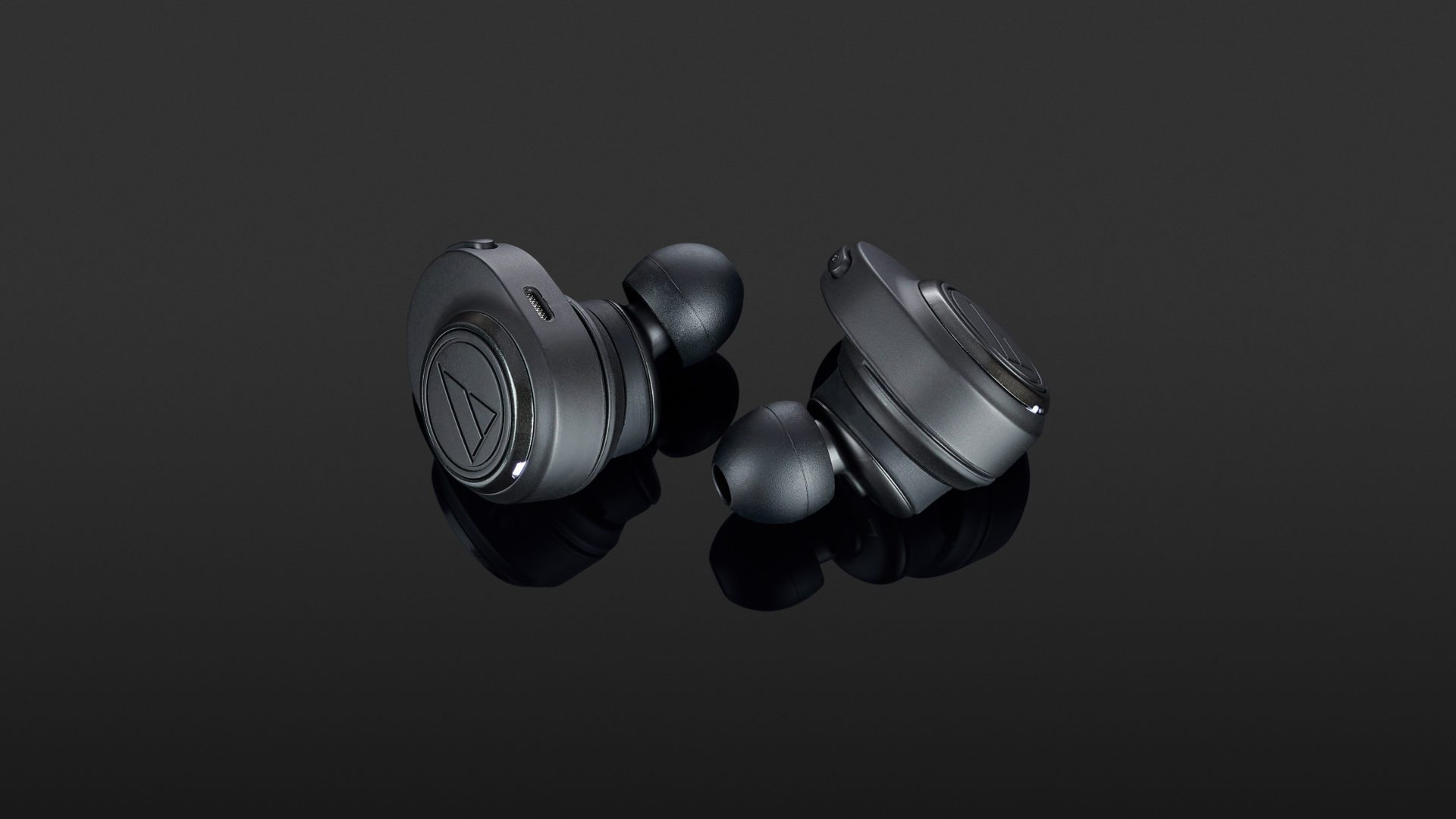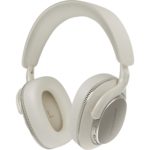The Audio-Technica ATH-CKR7TW sound neat, are well crafted, and have a good look. But the lack of touch controls or the looping of external noise through the internal microphone (Hear-Through Technology) makes the in-ears look a bit old-fashioned. Really new or fresh ideas, which would be relevant for a modern “True Wireless Lifestyle”, are unfortunately missing here.
“ATH-CKR7TW” sounds like it would make a secure and hard to hack password, but actually it’s the model name of Audio-Technica’s new true wireless in-ear headphones and that’s what the following test is about.
Audio-Technica choose a different way to go than Apple with their AirPods (tested). In the Californian in-ears, parts of the electronics protrude downwards in the form of rods, but the oval housing of the CKR7TWs sits in front of the auricles (for anatomy lovers: between Concha auricularis and Fossa triangularis), reminding me a bit of ear “tunnels” – the piercing popular with hipsters. These in-ears make an definite fashion statement and they are available in black, as well as a rather chic grey colour.
Mechanical
The in-ears stay in the ear primarily through the pressure that the auditory canal exerts on the ear-moulds (four sizes are supplied: XS, S, M and L). If this is too wobbly for you, you can also use the so-called “3D Loops”, which are also included in the package and nestle like “hooks” in the auricle. Support is necessary, as at 9 grams per unit the CKR7TWs already weigh a lot.
I have read reviews from other testers that say they could not achieve a firm and airtight fit in the ear. This shows how difficult it can be when industrial manufacturing meets something as malleable as human physiognomy. I myself can’t confirm this and was able to sink the in-ears flush into my ear, but the fit was very good, even without hooks, which I would like to partly attribute to the fact that my ears have a rather large and firm “tragus” (yes, it’s really called that – it’s the cartilage in front of the opening of the auditory canal), which holds the listeners firmly in place. However, after a while (with me the “pain threshold” was about 30 minutes) the weight in the auditory canal becomes noticeable and you feel a feeling of pressure.
Technical
The technical data of these in-ears reads promisingly: The 11 millimetre drivers provide an extremely wide frequency response from 5 Hz to 45 kHz and react with a sensitivity of 102 dB per milliwatt. The impedance of 16 Ohm is relatively irrelevant since the amplification takes place in the headphone itself. More interesting is the maximum operating time, with a battery charge of about six hours. The included case also functions as a charging cradle with an integrated battery, which provides another 9 hours of capacity. A full charge cycle takes about two hours (for the case: 5 hours).
The Bluetooth profiles offered are A2DP, AVRCP, HFP and HSP. Since Bluetooth 5.0 is used for radio communication, the connection to the terminal device (if the standard also supports this) is established quickly. Codecs that can be used are Qualcomm aptX, AAC and SBC. The BT profiles can be switched manually via an app called “Connect”. According to the instructions, this should be available for both iOS and Android, but I could not find it in the Play Store at the time of the test. If you use an Apple player (in the test I used an iPad Pro) in conjunction with the app, you can choose between AAC and SBC. If the stability of the BT line is poor, it should be possible to switch to a more robust codec, which was necessary in my case (but it didn’t help). Merely covering the in-ears with my hands was enough to bring the connection to a standstill. Also, the casual stowage of the mobile phone in my back pocket was sufficient that the wall of body tissue of my buttocks disturbed the near radio range. Additionally, after I switched to SBC on the iPad, my Android mobile phone (A7) didn’t want to connect to the in-ears anymore. So, I was back to square one. This made it necessary to put the headphones back into the charger several times (which caused a coupling reset) and then reconnect them, which I found a bit annoying, bringing us straight to the subject of practicality…
Practical
The only controls on the CKR7TW are two small knobs on the top of the case. The left one controls the volume (1x press = louder, 2x press = quieter), the right one controls play/pause (1x press), forward/back (2/3x press) and call answer. To switch the in-ears on and off, press for two seconds (for each of the two separately), to switch them off, press for four seconds.
After a short time, you’ll be looking enviously at competing products that switch themselves off when they’re no longer in your ear, because the Audio-Technicas are not only fiddly, they are also prone to errors. Several times in the test I triggered functions on the in-ear, although I just wanted to put them back into position. If you compare them to the competitors, Apple (AirPods [review]) or Sennheiser (Momentum True Wireless [review]), you’ll notice that the charger cradle – like the in-ears themselves – is a rather bulky thing that you wouldn’t want to put in your pocket. I was also not completely satisfied with the fact that apart from the charger cable for the case, (USB-A on USB-Micro-B) no power supply is included, but the others aren’t any better on this score.
Sound
An undeniable sound advantage of all “true wireless” in-ears is, of course, the absence of a cable and the CKR7TW also benefits from this because there is no structure-borne noise transmitted from the power conductor. The undisturbed sound staging can be quite pleasing as the bass foundation is solid but does not push itself into the foreground. The mids are present and binding, and with much more self-confidence than the bass. Audio-Technica has presumably thought of frequent callers who want to use the CKR7TW mainly for their business calls, and more mids bring more speech intelligibility. In the treble, the sound is a little more relaxed and, depending on the material supplied, a subtle high-end shimmer can even be heard. Due to the slight midrange dominance, the stereo field looks rather compact. In short: The CKR7TW sound good, but they are not particularly comfortable acoustically.
Speech
The slight centre presence proves to be quite pleasant when telephoning and the speech of the other person reaches the ear with relatively high intelligibility. For the caller at the other end, it is not quite as pleasant and the voice seems – in comparison to the internal microphone of the mobile phone – much further away and more reverberant. Here, however, physics simply sets limits, because the microphone sitting in the right in-ear is simply further from the mouth.
Technical specifications
- Ear couplingIn-ear
- Typeclosed
- Transducer principledynamic
- Frequency response (headphones)5 - 45.000 Hz
- Impedance16 ohms
- Sound pressure level (SPL)102 dB/mW (+/- 3dB) dB
- Weight without cable18 g
What's in the box
- 4 ear tips (XS, S, M, L)
- 3D Loops
- USB charging cable
- Charging case
Special features
- BT codecs: aptX, AAC, SBC
- BT version: 5.0
- BT profiles: A2DP, AVRCP, HFP, HSP
- Charging time: headphones approx. 2 hours; charge case approx. 5 hours.




















































You mention the you accidentally touch the buttons when adjusting them. Are you dyslexic? Then say they could have had touch controls which are much more fiddly in comparison..
Then u say you lose connection with your hands over them…I can cup my hands over them and walk 10 meters away, still connected.
Apart from some ridiculous points, the mid range description was pretty accurate and that’s why they shine. No enhanced bass that shadows everything with a fuzzy hollow beat that sounds like it’s playing through your wall. People call that warm mids. I call it interference.